We may earn revenue from the products available on this page and participate in affiliate programs. Learn more ›
All sorts of interesting one- and two-wheeled vehicles crisscross the streets of my city, including an increasing number of increasingly affordable, portable transport. Spandex-clad cyclists take advantage of protected lanes, electric scooters fly over sidewalks (and anywhere), and occasionally, an odd unicyclist or one-wheeler will break up the predictability. I particularly like to watch foldable e-bike riders who go from trail to train, transforming their personal transit into a cube to carry through a crowd. This now-you-see-it now-you-don’t collapsible electric bikes offer power assistance for commuting or errands without taking up valuable real estate in an apartment or townhouse. These flexible options also can often fit into an SUV or RV without purchasing a heavy-duty and often expensive rack. We’ve rounded up the most reliable options from the best folding electric bikes to match every riding style and need.
Best overall: Lectric XP 3.0
Best cargo: Tern Vektron S10
Best splurge: Gocycle G4i
Best trike: Lectric XP Trike
Best budget: Ride1Up Portola
How we selected the best folding electric bikes
I’m still hunting for my spirit bike, like the one in Pee-wee’s Big Adventure. In the meantime, I’ve owned and tested many different bikes—electric and not, folding and not—on my commute. I’ve combined this experience with that of the PopSci team and conducted extensive research into expert and customer reviews to select the models on this list.
The best folding electric bikes: Reviews & Recommendations
An electric folding bike must balance having enough oomph to make it to work and back and being easier to store and transport than a full-sized e-bike. Collapsible models tend to have shorter wheelbases, lower standover heights, and an upright riding position so you can see clearly in traffic or on crowded paths. Wheels are usually 16 to 20 inches in diameter, which results in feeling more of the bumps and cracks of the road. Skinny tires will be faster rolling and lighter, but high volume, wider tires can help absorb the road chatter. In general, folding electric bikes for adults tend to be rougher than other cycles.
If you ride other bikes a lot, folding bikes takes some getting used to. Petite riders may feel more in control over the more diminutive stature, while taller riders may feel like a clown on a minibike. The sharper turning radius is ultimately a win. Still, it can feel squirrely at first if you’re used to broader, more stable handlebars, and sometimes the gearing can make it feel like you’re pedaling furiously but getting nowhere. Get a few miles under your belt, however, and you’ll find a new rhythm.
To help you find the right foldable e-bike, prioritize which features are must-haves by thinking about where you want to ride it, how far you’d like to go, what else you might want to carry, and how small the bike needs to be for storage. With that knowledge, you’re ready to find your best folding e-bike from our top picks.
Best overall: Lectric XP 3.0
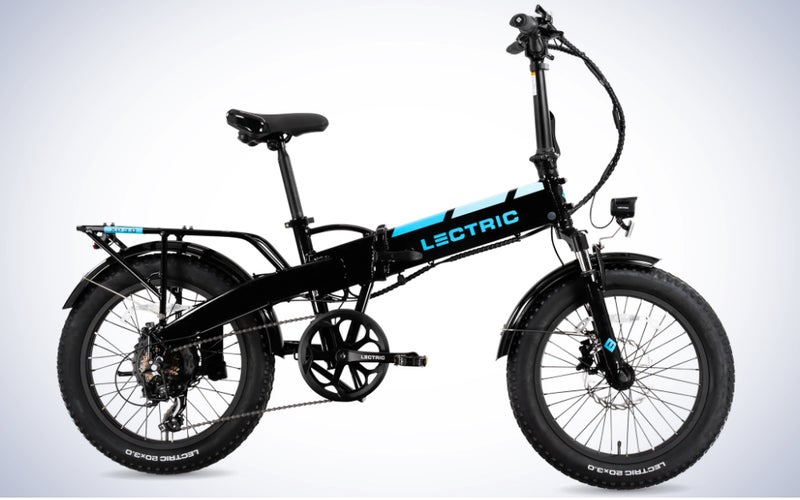
Specs
Unfolded bike: 66 inches long by 25 inches wide by 47 inches tall
Folded bike: 37 inches by 18 inches wide by 28 inches tall
Motor: 500W hub motor with 55Nm of torque
Battery: 672Wh lithium-ion
Riding range: Up to 45 miles using pedal assist or up to 20 using throttle only
Class: 2
Top speed: 20 mph
Bike weight: 64 pounds
Carrying capacity: 330 pounds
Pros
Front oil suspension fork
Rear rack that can hold up to 150 pounds
Five levels of pedal assist plus throttle
Front and rear hydraulic brakes
Integrated headlights and rear lights
Front and rear fenders
Removable battery
External charging port
Slime-lined tires to prevent flats
Multiple mounting points for additional accessories
1-year warranty
Cons
Long-range battery available for extra
Well-organized, but external wires and cords
Nothing to secure the bike when folded
Lectric is one of the OGs of foldable electric bikes, so much so that riding this around town nearly always gets me a shout or recognition from another Lectric rider. They’ll chat with me at a stop or ride alongside me for a bit, and I can honestly say it’s never happened to me on another brand of e-bike. The Lectric XP 3.0 finetunes what it’s learned from previous models for an affordable and fun ride with five pedal assist levels and a throttle. Lectric added more juice to the 500W motor, which can peak at 1,000W and kick out 55Nm of torque. The tires are fat-tire light—20 by 3 inches—which makes for a more cushioned ride with the front suspension fork. The improved gearing means less furious pedaling than other models to get up to top speeds. Lectric lists the bike at $1,300, but you can often find it on sale—and yet, it still has hydraulic brakes, which are a rarity at this price point.
The XP 3.0 comes stock with many nice commuter extras, like integrated lights, front and rear fenders, and a monster rear rack that can hold up to 150 pounds. Lectric offers a ton of accessories, including a passenger seat for light riders (e.g., kids).
For most people, the Lectric will meet their folding e-bike needs, but it’s not perfect. Lectric, more than many brands, makes you well aware of cords. While the wiring up front is well-organized, nothing is internally threaded. It folds at two points—at mid-frame and the handlebars—and it frankly takes some practice to align pedals, handlebars, and wheels just right. You’ll also need a bungee (or something) to keep everything nice and tight if you want to move the bike while folded. But it does get small enough to go into a typical car trunk (not a Miata, let’s not get crazy). It is, however, a heavy 64 pounds unless you scrap the battery.
Best cargo: Tern Vektron S10
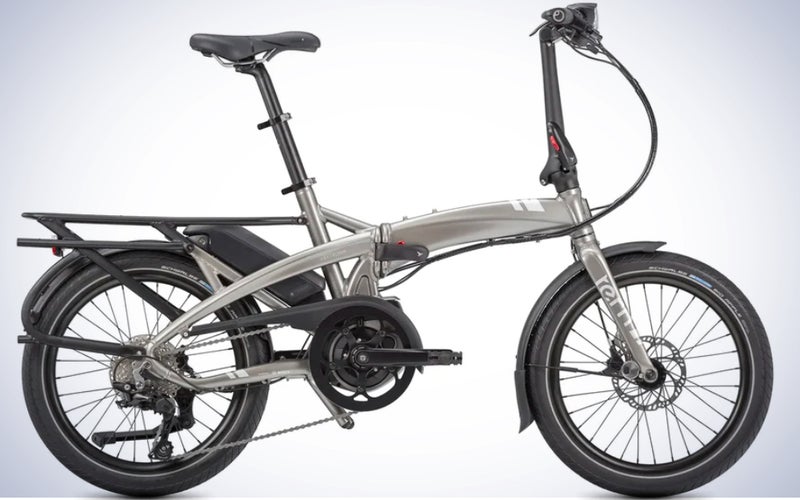
Specs
Folded bike: 33.7 inches long by 15.7 inches wide by 26.6 inches tall
Motor: 250W Bosch Performance Drive Unit with 65Nm torque
Battery: 400Wh Bosch PowerPack
Riding range: Up to 63 miles
Class: 1
Top speed: 20 mph
Bike weight: 48.6 pounds
Carrying capacity: 275.6 pounds
Pros
Five levels of pedal assist with shift optimization
Magura MT4 hydraulic disc brakes
10-speed Shimano Deore drive train
Integrated headlights and rear lights
Front and rear fenders
Atlas V Rack on the rear that holds up to 60 pounds and accepts Thule Yepp Maxi and Dash RM child seats without adapters
Chain guard stay
Grip pad under saddle to use as a handle for shoulder carrying
Removable battery
Cons
Single-side kickstand
Overall capacity weight is low for the format
The Tern Vektron S10 is a foldable e-bike for adults who aim to use it for most of their transportation needs, including shuttling kids around and hauling groceries. It’s also a folding bike that feels nearly as stiff as a non-folding model, thanks to the advanced welding techniques, gussets for the OCL+ frame joint, and custom forks. A telescoping seat post allows the frame to fit riders from 4’10” to 6’5”.
Tern has a long history of making cargo bicycles that handle being loaded down well, and the Vektron S10 is no exception. The robust Atlas V Rack can hold up to 60 pounds, whether that’s groceries in some of Tern’s accessories or a child seat made by Thule or Dash. A Bosch Performance Drive Unit and 400Wh Bosch PowerPack, a pair renowned for high performance and quiet operation, power this cargo hauler. Other name-brand parts, like a 10-speed Shimano drivetrain and Magura hydraulic brakes, help account for the price tag of about $3,300. Make no mistake: The Vektron S10 expects to replace a car. Practically speaking, the overall carrying capacity for the bike is a little low at 275 pounds.
Despite being a cargo bike, the Vektron is a portable electric bike when you drop the seat post, fold the mid-point in the frame, and then the handlebars. At 50 pounds, it’s not the lightest but not the heaviest. Most Terns also have another advantage for storage: They can be tipped on the rack end to be stored vertically.
Best splurge: Gocycle G4i
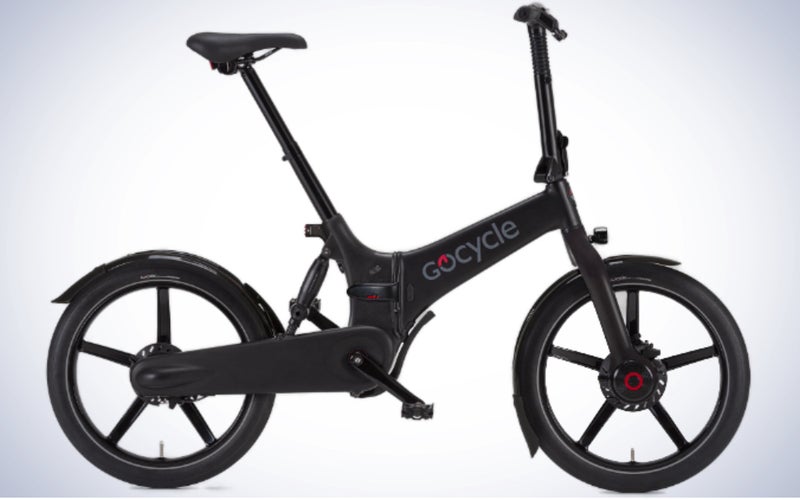
Specs
Folded bike: 32.7 inches by 14.6 inches wide by 29.5 inches tall with removable pedal detached
Motor: Gocycle proprietary 500W front hub motor
Battery: 375Wh lithium-ion
Riding range: Up to 50 miles
Class: 2
Top speed: 20 mph
Bike weight: 37.7 pounds
Maximum rider weight: 220 pounds
Pros
Four pedal assist modes, can be customized
Daytime running lights
GocycleConnect App
Hydraulic disc brakes
Integrated front and rear lights
Front and rear fenders
Carbon fiber single-sided front fork
USB charger
Removable battery
Very fast fold
Cons
Many proprietary parts that may be hard to service or replace
MotoGP-inspired tires can be prone to flats
The Gocycle G4i looks a bit like the Tron Light Cycle if it were designed for a commuter and not battling on The Grid. This high-end model will set you back about $5,000 for a wide array of cutting-edge technologies squeezed into one of the lightest folding electric bikes on the market. Gocycle’s design is led by Richard Thorpe, a man so obsessed with creating “the perfect e-bike” that he left his job at McLaren Cars armed with experience developing lightweight components.
The G4i weighs just shy of 38 pounds thanks to a frame made of an aluminum alloy frame with a carbon fiber mid-drive and a proprietary rear suspension. The forks that hold the wheels in place are also carbon fiber and notably single-sided to save weight and make for a fast folding electric bike. It rests on the wheels when folded, which you can still use to roll it while tilting it back a little.
That’s the thing about Gocycles: They feel designed with the user in mind. The bike feels agile and accelerates quickly thanks to a proprietary 500W G4drive engine paired with predictive electronic gear shifting and three customizable pedal assist levels. The drive train (again, proprietary) is enclosed to keep work pants clean from riding or carrying it into an office or apartment after commuting. And—no surprise—the hydraulic brakes are also bespoke to Gocycle. The proprietary parts let Gocycle flex its innovative muscles but can lead to expensive or time-consuming repairs should something go wrong.
The frame is just one size, but other parts move to adjust to a rider. One thing that’s noticeably missing is a screen on the handlebars. Instead, there’s a light-based display that takes some getting used to and a wide “daytime running light” that stretches from grip to grip. For metrics and customized driving modes, riders must use the GocycleConnect App and add a phone holder.
Best trike: Lectric XP Trike
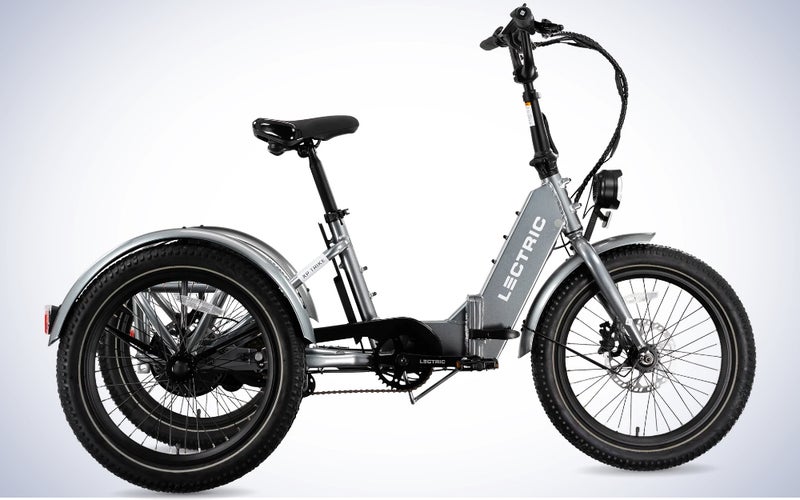
Specs
Unfolded bike: 63.5 inches long by 30.5 inches wide by 43 inches tall
Folded bike: 38.5 inches by 30.5 inches wide by 30 inches tall
Motor: 500W rear hub motor on the differential axle, 65Nm or torque
Battery: 672Wh lithium-ion
Riding range: Up to 60 miles using pedal assist or up to 55 using throttle only
Class: 2
Top speed: 14 mph
Bike weight: 69.5 pounds
Carrying capacity: 415 pounds
Pros
Three wheels expand the potential rider base
Differential axle for smooth turning
Five levels of pedal assist plus throttle
Front and rear hydraulic brakes
Two parking brakes
Integrated headlights, rear lights, and brake lights
Front and rear fenders
A ton of additional accessories
Removable battery
External charging port
1-year warranty
Cons
Three wheels mean wider turning radius
Added accessories usually need to be removed before folding
Ships with beginner mode, which limits the speed
The Lectric XP Trike packs a ton of higher-end features into an electric tricycle that makes cycling more accessible. With a suggested retail of about $1,500, this Class 2 trike offers five levels of pedal assist and has a throttle to help with starts or offer breaks from pedaling. Lectric ships the trike in a beginner mode that slows acceleration and limits the top speed to 5 mph. This mode prevents people who haven’t been riding electric vehicles from jumping forward or going faster than they’re ready. Higher speeds can be unlocked, but this trike isn’t a speed demon. Top speed is 14 mph.
Let’s talk about the tricycle format. First, it has an incredibly low standover height of less than 14 inches, making it super easy to hop on and off. Lectric packed a 500W engine into the rear differential axle, which lets each rear wheel turn independently for smoother turning and enough torque to chug up big hills. All trikes can tip, though; expect to take turns slower and leave more room for stopping until you get used to the handling. The XP Trike also boasts hydraulic front and rear bikes, a surprisingly high-end feature for the price point.
And yes, this bad boy folds. However, it will take a few minutes and removing most additional accessories. Considering that this is a trike, the 69.5 pounds is light for the form. Removing the battery will shave about seven pounds off. Folded up, the trike can fit in the back of minivans or SUVs, though smaller hatchbacks may need some extra finagling. The XP Trike accommodates riders from 4’10” to 6’4” that weigh up to 330 pounds. Plus, the bike can still haul another 85 pounds of cargo. Lectric also offers a ton of add-ons, like a seat with back support, suspension seat stems, and baskets.
Best budget: Ride1Up Portola
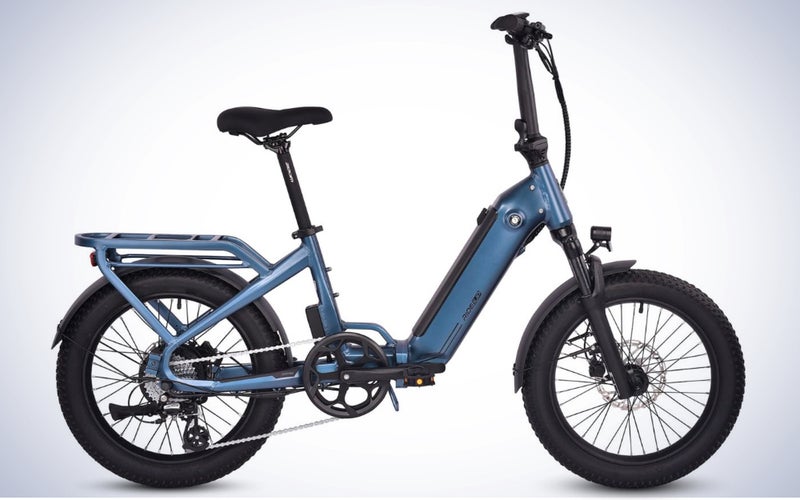
Specs
Unfolded bike: 66.2 inches long by 19 inches wide by 44.4 inches tall
Folded bike: 33 inches long by 19 inches wide by 29.5 inches tall
Motor: 750W geared hub motor with 65Nm torque
Battery: 500Wh
Riding range: Up to 40 miles
Class: Switchable to 1, 2 or 3
Top speed: 28 mph
Bike weight: 59 pounds
Carrying capacity: 300 pounds
Pros
Five pedal assist modes plus throttle
Front suspension fork
Dual-piston hydraulic brakes
Front and back fenders
Rear rack holds up to 130 pounds
Integrated front and rear bikes
Folding pedals
Chainguard stay
Short velcro strap to hold the bike together when folded
1-year warranty
Cons
Long-range battery available for extra
Well-organized, but external wires and cords
Taller riders may find leg extension lacking
The Ride1Up Portola has a big ol’ motor—750W, the largest of this roundup. It also features a front suspension fork, 8-speed drivetrain, hydraulic brakes, and a muscular welded rear rack that can hold up to 130 pounds. These details are surprising to find on a folding e-bike and downright shocking to find on one that costs less than a grand.
The Portola offers a lot to like, especially at the price point. Sturdy 20-inch by 3-inch tires and a front suspension fork work together to keep the rider relatively comfortable. There’s only one frame size, which Ride1Up calls “one size fits most,” or in this case, means riders from 4’10” to 6’4”—though taller riders or long-legged ones note they’d like a little more extension when they pedal.
The Portola initially starts with a 10.4Ah battery, but an upgrade to 13.4Ah is only $100 more. With five pedal-assist levels and a throttle, you might want the extra juice. The range is up to 40—or 45 with the larger battery. The e-bike also can be switched between Class 1, 2, or 3, depending on whether you want to limit or unleash a potential top speed of 28 mph. And here’s one very simple but very nice touch that many folding bike makers overlook: The Portola has a small velcro strap to secure the bike when it’s folded. It takes some fussing to get the wheels and handlebars just right, but folding bike owners frequently add their own bungees or straps because nothing was included.
What to consider when searching for the best folding electric bikes
Usually, a search for an e-bike begins with sticker shock, mainly if you don’t ride other bicycles. You can find budget electric bikes under $1,000, though models quickly get into the multiple thousands. Expect to find more powerful motors with more torque, larger batteries, and frames made of higher-quality, often lighter-weight materials as the price climbs. They’re like cars: You can find a reasonably priced, reliable model or spend serious bucks on high-end components, luxury features, and eye-grabbing designs. While the options may be daunting, there is a model out there to suit your tastes and budget, whether you’re looking for the best electric commuter bike or the best fat tire electric bike.
It’s also worth checking whether your state offers tax credits or rebates for e-bikes to encourage adoption.
Classes
E-bikes occupy a weird space in transportation between traditional, aka “acoustic,” bicycles and mopeds. For the most part, electric bicycle owners need to wear helmets, but they don’t need special licenses, insurance, or vehicle registration. Most states recognize three different e-bike classes to help determine the literal rules of the road. Here’s the quick version:
Class 1: a pedal-assist system motor that stops assistance at 20 mph.
Class 2: a throttle motor that stops assistance at 20 mph.
Class 3: a pedal-assist system motor that stops assistance at 28 mph.
Some manufacturers blend these classes or ship a Class 1 that can be turned into a Class 3 with some tinkering.
Look into your state’s rules or check this guide for where and how you can operate your class e-bike. Sometimes, trails or specific parks prohibit certain bike classes. Around my city, various counties and neighborhoods put signs along popular bike paths to encourage slow speeds and trail sharing.
Motors
A great e-bike makes riding feel effortless, even when climbing a steep hill. Motors help riders go farther and faster through a pedal-assist system (PAS) or a throttle. A PAS e-bike can supply different levels of support using controls on the handlebars and sensors that detect how fast or hard you’re pedaling. Throttle systems deliver a quick burst of power without pedaling, more akin to a scooter or moped. Some bikes have both features.
But what makes for a good motor? Look for a combination of watts and torque. Watts indicate the motor output, while torque is the acceleration or climbing force. Higher watts and higher torque usually equal higher performance, but some manufacturers have unique tuning that eek more torque out of lower output motors. Whether you need that is another matter. Flat commutes on paved surfaces don’t need high torque. Very fit riders might not need the power. Consider your fitness, the terrain of most rides, and how long those rides will be.
Riding range and battery life
The good news about an e-bike with a dead battery is that you can pedal. Still, most people don’t want to run out of battery. Published ranges are suggestions based on optimal riding conditions. How long the battery lasts relies on dozens of factors: rider and cargo weight, whether the route has hills, and how much assistance the motor provides. More help—or a lot of throttling—drains the battery faster. Commutes are easy to plan for; the distance doesn’t change. Freeform or unplanned rides can be dicier. A good rule of thumb is to plan trips well under the top end of the published riding range and charge the battery for every ride.
Some models have removable batteries that allow for swapping a dead one out for another or extended-capacity versions to lengthen ride time. Generally, bigger batteries are heavier but provide greater peace of mind.
FAQs
Q: What are the disadvantages of electric bikes?
E-bikes—folding or not—can be a more earth-friendly way of handling errands and regular commutes than driving a gas-powered car. That said, e-bikes typically cost more than their unpowered counterparts (though those can get quite premium, as well). E-bikes also need to be recharged, so be sure you have a space with a convenient charging port or find a model with a removable battery. Eventually, batteries will degrade and need to be replaced. Like all bikes, they will need regular maintenance. While any bike shop can service many models, some have proprietary parts that may be hard to get.
An electric folding bike has a few additional things to consider. All moving parts wear with use and repetition, including the folding frame of a collapsible electric bike and the bolts or clips that secure it.
Q: Are folding electric bikes good for long distances?
Check the model’s published range and know that the top-line number may be purely aspirational. How long a battery lasts depends on your weight, your cargo’s weight, the assist level being used, and the terrain. If you’re riding on flat land with no pedal assistance, that battery will last a good long while. However, using the highest assist level while going exclusively uphill into a headwind … well, expect the lowest end of that published range.
People used to traditional or full-sized bikes may find riding folding models inherently less comfortable. Foldable models often have upright riding positions and some comfort features, but the smaller wheels and general lack of suspension mean you feel every crack, root, and bump.
Q: How heavy are folding electric bikes?
We’ve seen electric bikes weigh anywhere from just shy of 30 pounds to 90 pounds. Folding e-bikes are in the same ballpark, though you’ll find fewer of those 90-pounders. Sixty pounds is 60 pounds, but even unfolded, a folding e-bike’s smaller wheels and shorter wheelbase are easier to maneuver than most traditional bicycles or e-bikes. Folded, you don’t have to deal with balancing the weight or handlebars turning inconveniently.
Final thoughts on the best folding electric bikes
Best overall: Lectric XP 3.0
Best cargo: Tern Vektron S10
Best splurge: Gocycle G4i
Best trike: Lectric XP Trike
Best budget: Ride1Up Portola
Folding electric bikes are a funny sort of transportation. They’re purpose-built to be easy to transport or store, which may mean some compromises in riding comfort. However, this category of bikes has come a long way, incorporating fatter tires, more suspension systems, and hydraulic brakes for superior stopping power and more options than ever before. Find the model that fits—literally—into your apartment, car, or commute, and enjoy the ride.
Why trust us
Popular Science started writing about technology more than 150 years ago. There was no such thing as “gadget writing” when we published our first issue in 1872, but if there was, our mission to demystify the world of innovation for everyday readers means we would have been all over it. Here in the present, PopSci is fully committed to helping readers navigate the increasingly intimidating array of devices on the market right now.
Our writers and editors have combined decades of experience covering and reviewing consumer electronics. We each have our own obsessive specialties—from high-end audio to video games to cameras and beyond—but when we’re reviewing devices outside of our immediate wheelhouses, we do our best to seek out trustworthy voices and opinions to help guide people to the very best recommendations. We know we don’t know everything, but we’re excited to live through the analysis paralysis that internet shopping can spur so readers don’t have to.
>>> Read full article>>>
Copyright for syndicated content belongs to the linked Source : Popular Science – https://www.popsci.com/gear/best-folding-electric-bikes/






























